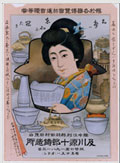The history of iron culture in Oshu city where NakedPan is made dates back about 900 years when it was the time of the Crusades in the West and when Kyoto was the capital of Japan. It began when a lord of that time ordered Buddhist alter equipment to be made as all the materials needed for casting were found in this area.
By the first half of the Edo Period which is about 400 years ago, tea pots made of cast iron were rare and precious. Later, with the spread of tea, iron kettles were also made for the common people.
Nowadays, not only iron kettles but many other cast iron products are produced. Besides being used in Japan, they are now being sent overseas as well.
Environment
Situated at about 500km NNE of Tokyo that is a city of high technology,
Oshu city is said to be a treasury of Japan’s folklore. The land is so blessed with nature that macrobiotic chefs and people who admire slow food come here for its food supply.
In a setting like that of old Japan, studios of just a few iron-casting craftsmen and small factories of no more than 50 workers produce traditional hand-made quality iron kettles and pots to be used around the world.
With its history and environment, the NakedPan which has inherited the traditional process of iron kettle making is an iron pan that is made by simply applying heat after casting. It is in other words, a natural pan made from a single material. Therefore, it is durable, long-lasting, and even recyclable.
Using such a natural pan as the NakedPan matches the idea of cooking with organic vegetables and meat for safe and natural cooking.

Cast iron manufacturer tracing history back 150 years. Specialising in manufacturing of iron kettles, teapots and pans. In the 11th and 12th centruy, cast iron techniques were active in the same City where Oigen is located. It is still the centre of cast iron production in Japan.

 |

The historyof iron culture in Oshu city where NakedPan is made dates back about 900 years when it was the time of the Crusades in the West and when Kyoto was the capital of Japan. It began when a lord of that time ordered Buddhist alter equipment to be made as all the materials needed for casting were found in this area. By the first half of the Edo Period which is ablut 400 years ago, tea pots made of cast iron were rare and precious. Later, with the spread of tea, iron kettles were also made for the common people. Nowadays, not only iron kettles but many other cast iron products are produced. Besides being used in Japan, they are now being sent overseas as well. |

Situated at about 500km NNE of Tokyo that is a city of high technology, Oshu city is said to be a treasury of Japan's folklore. The land is so blessed with nature that macrobiotic chefs and people who admire slow food come here for its food supply. In a seeting like that of old Japan, studios of just a few iron-casting craftsmen and small factories of no more than 50 workers produce traditional hand-made qaulity iron kettles to be used around the world.
 |

Horinouchi Hada-cho Mizusawa-ku Oshu-City Iwate Prefecture 023-0132 Japan

Japan
Major department stores – Mitsukoshi Takashimaya
Online via the Internet Direct Sales through own shops
Overseas
Teapots
The President, Ms Oigen, visits Europe (France, Germany and the United Kingdom). |

- 2006 September
- Registered patent in Japan – No. 3848264
[Iron cast products and its surface finish]
- 2007 February
- Nuremburg, Germany
Exhibited at the Organic Trade Fair – BioFach 2007
- 2007 June
- Ministry of Economy, Trade and Industry
Chosen for “2007 Vigorous Manufacturing of 300 Small and Medium Enterprises”
- 2007 July
- Ministry of Economy, Trade and Industry
Won Chief of Bureau Award
Tohuku Economic Industrial Bureau in
“2007 Manufacturing Japan Award”
- 2007 October
- NakedPan Oval 34.5cm x28cm won “2007 Good Design Award”















